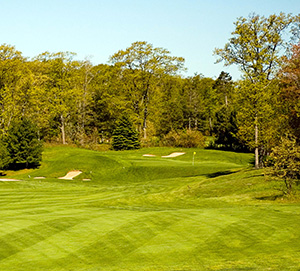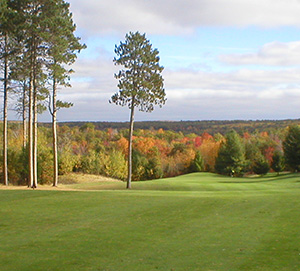The White Pine way
From the selection of the land to the low-pressure irrigation system, Northeast Michigan’s White Pine National Golf Resort harmonizes with nature and golfers.
As the son of Clarence Wolfrom, a longstanding superintendent and Michigan Golf Hall of Famer, Bruce Wolfrom was introduced to the intricacies of course design at an early age.
“When I was a little boy, I’d go with my father when he was asked to come and lay out a new course or consult on problems courses were having,” Wolfrom says. “I was always intrigued with the prospect of taming nature.”
Clarence, Bruce’s father, was the superintendent of Maple Lane Golf Course, a public course located in Sterling Heights, Mich., for 53 years. Along the way he helped found the Michigan Turfgrass Foundation, and he also helped many turf professionals get their start in the industry. Bruce and his older brother Clem were two of those who were helped by Clarence’s influence, as they followed in their father’s footsteps. Bruce accepted a position as the superintendent of Treetops, based in Gaylord, Mich., while Clem was hired as superintendent of the private Detroit Golf Club.
“We had both worked at Donald Ross-designed courses in the past and had gone through the process of bringing the original intent of the design back to the courses we were at,” he says. “It led to an understanding of the ‘why’ behind good design.”
With their passion for course maintenance instilled as children, Bruce and Clem often discussed the possibility of designing their very own course, utilizing the methods they had learned from some of the world’s most respected designers. They were interested in many locations, but as they began to search for land, they realized just how challenging it is to find property suited for a golf course.
“We had to have land that was naturally laid out for the game of golf, which would cut our construction costs. It also had to have the right soil and elevation,” says Wolfrom. “We’d seen hundreds of sites, but they were too low-lying, or their soil would be heavy clay, causing drainage problems.”
But, one 400-acre property immediately caught their attention. Located in Hubbard Lake, Mich., a resort area they had frequented as children, the land featured majestic white pine and oak trees, as well as high terrain and light sandy loam soil, allowing Bruce and Clem to operate a course primarily designed by nature.
“I’ve always believed that nature is the best designer of the landscape,” he says. “It’s obvious that the contours of this land weren’t made with bulldozers, but by Mother Nature.”
Grand opening
The Wolfroms purchased the property in 1991 and, after 21 months of construction and renovation, opened White Pine National Golf Resort in September 1992.
From the back tees, the course measures 6,752 yards. Although White Pine is not remarkably long or narrow, its bunker placement and small, undulating greens offer even the most experienced golfers an examination of their skills.
Featuring five sets of tees, the par-72 layout was designed to tailor to golfers of all experience levels.
“We’re proud of the number of new golfers who have been introduced to golf at White Pine,” says Wolfrom. “After 20 years, we’re starting to see some of the kids who learned the game here, come back to their roots, so to speak, and bring their friends.”
White Pine’s greens stimp at 10 all season long. To provide further relief to inexperienced golfers, the course is particularly unusual for its lack of water hazards.
“Part of our design aesthetic was to eliminate water hazards. Besides the intimidation factor that water can add to casual golfers, there was a maintenance philosophy behind that decision,” Wolfrom says.
Most courses with natural ponds or streams are generally located in valleys or other types of low-lying terrains, which are more difficult to drain. By excluding water hazards, White Pine does not require any drain pipes. In fact, with its high terrain and natural drainage system, the course’s turf is protected from disease and damage caused by torrential downpour and flooding.
“In 20 years, the course has only been closed once due to a two-hour-long storm that left behind four inches of rain. While other local courses were closed for a few days, White Pine was open again in a few hours.”
Less pressure
Although White Pine’s lack of water hazards is uncommon, its focus on environmental friendliness is groundbreaking. White Pine utilizes a low-pressure irrigation system, thereby minimizing water and energy, a novel irrigation method.
“As courses became longer, irrigation designers increased the pressure that water was subjected to in order to irrigate their courses,” says Wolfrom. “To move more water farther at higher pressure, you need bigger pumps. And, of course, the bigger the pump, the more electricity.”
After observing other courses’ irrigation methods, Wolfrom has theorized that, with larger, high-pressure irrigation systems, water is often sprayed too far. As a result, most of the water is either windswept or evaporated rather than actually irrigating the turf.
“We believed we could accomplish better saturation with less energy by using more sprinkler heads at lower pressure. It’s the single best decision we made in the beginning that minimized our impact on the environment.”
Since 1992, White Pine’s electric bill has consistently been 50 percent lower than other courses of similar length and elevation. The system has also saved millions of gallons of water.
National environmental associations and organizations have taken notice. Back in 2000, White Pine received recognition as a regional winner of the GCSAA’s Environmental Stewardship Award. Later that year, Audubon International named the course one of the top 100 environmentally friendly courses in the U.S.
“From the selection of the land, to its one-of-a-kind low-pressure irrigation system, White Pine’s design and maintenance continues to have a minimal impact on the environment,” Wolfrom says.
Golf and nature
As general manager, Wolfrom’s current staff consists of only four maintenance professionals, who help him sustain White Pine’s irrigation system and turf on a daily basis. With a staff that is smaller than usual, Wolfrom has trained his team members to multitask, minimize errors and conserve resources.
“When you think about environmental friendliness, efficiency has a lot to do with it. By guiding my staff and initiating training programs, unnecessary errors have been eliminated and fuel costs have been reduced by 30 percent in the past year,” he says.
Through their commitment to ecology and conservation, Wolfrom and his staff have developed a cost-effective course, which saves thousands of dollars each year. In doing so, golfers are able to enjoy White Pine’s natural settings — and fair prices.
“Our customer base demands value for their dollar, so being environmentally conscious is best for our budget and our golfers,” he says. “When folks golf here and see deer grazing along the fairways or discover a newborn fawn in the rough, they understand that White Pine National is a great place for golf and for nature.”
Michigan-based freelance writer Chris Lewis specializes in reporting on golf in the U.S. This is his first story for Golfdom.










